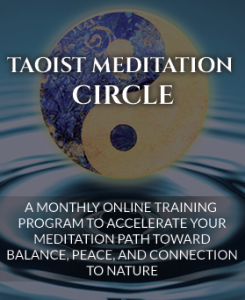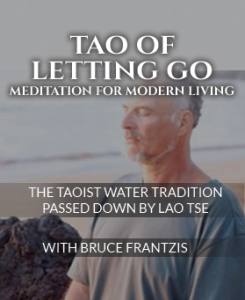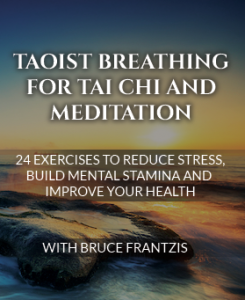When you learn to read and write there is an assumption that you already know the alphabet. Likewise, when you are practicing qigong, bagua or tai chi you are mainly learning the basic ways in which chi works in relation to health, chi development and internal power generation.
Now whether it gets called qigong, neigong, energy exercises or any one of 30 other different names that people will attach to the practices of internal energy development, you are essentially learning about chi.
Learning about chi (subjectively through experience) is equivalent to practicing the alphabet. You must know the ABC’s of chi to engage in Taoist meditation. In this post I want to talk about the importance of building a solid foundation, and where that leads in your own transformational journey…
Advancing Your Practices One Step at a Time
Now, if you are going to practice bagua and tai chi as meditation, you first must have the basic chi work of qigong, bagua and/or tai chi together. You’ve got to know the movements, how to move chi through your body and both must be integrated in your body. At the highest levels of chi development you integrate each of the 16 neigong components in your practice.
Equally, sitting meditation can be done as qigong. However, in classic Taoist thought, it’s called sitting qigong among insiders and not mediation.
There’s also the subject of sexual qigong. The first stage is about how to enhance pleasure, performance and libido because all of them are dependent on the state of the general chi in your body and mind. The second stage goes deeper, using the practice to explore your spirit in relation to your partner.
Whatever practice you choose, the method changes dramatically when you move from practicing for health or energy into the realms of meditation because a lot more is happening when you deal with the spirit. In Taoist meditation, the assumption is that you have already taken the time to learn alphabet or basics of chi movement through a medium (specific regular daily practice), through which you’re now going to integrate meditation into that practice which is a whole different matter.
Chi Work is an Important Foundation
So to practice sitting meditation, you would start by learning sitting qigong to learn how chi moves while sitting. If you were going to practice tai chi as meditation, you would already know the movements and chi work associated with tai chi. Only then would you move forward into meditation.
This is not a moot point—it is very important. It is common for many students to approach mediation without having completed the initial chi work and then wonder why meditation is so difficult. There are many practices chi work such as tai chi, qigong and bagua.
It is essential to understand how important the preliminary chi work is for meditation. If you’re truly committed to meditation or a spiritual path then it would be wise to learn a chi practice for your body and stick with it until you reach a high level of competence. Your access point in meditation is through your body so by developing your body’s chi you will greatly enhance the possibility of success as you move into spiritual work.
Shengong: Real Meditation and Spiritual Work
There is a line that you must cross after you become proficient in a moving practice. When it happens, something important is added.
Chi practices can make your body healthier and physically stronger. Basically they make you a significantly stronger and better-functioning animal.
The term qigong can be thought of very simply as the way in which you develop or cultivate chi. If you don’t have chi, how do you get it? How do you balance it through your body? How do you make it work so it makes you stronger—physically, mentally and whichever way you want it.
Once you answer these have the chi, you are ready to cross the line.
Whereas chi or qi means “energy,” shen means “spirit.” Spirit equals meditation, which equals spirituality. So the term shengong literally means “spirit work.”
Meditation is about going beyond the energy of your flesh and internal organs, where at a base level you are simply dealing with the primal or instinctual emotions.
Meditation moves you towards more refined levels. These higher levels of emotion and awareness are at a much higher frequency. Here revamping and rewiring the underlying ability to think involves very little thought. This includes dealing with the energy associated with the psychic world, psychic sensitivity and psychic abilities.
Sensitivity to the Unseen World
Just as people can learn to be sensitive to bodily chi, they can also learn to be sensitive to the unseen world. Once this potential is activated the subject of karma then comes into play. Karma is not even bound by the physical body you have at the moment. Shengong starts to work with chi that is beyond the physical body.
If you wish to take the position of reincarnation, which involves moving between physical bodies, we’re then talking about a person’s essence. From a Christian position, this is that which goes with you after you die—either to heaven or hell.
Generally any issues from the third to seventh energy bodies (emotional, mental, psychic, karmic and essence) are under the giant framework called shen or spirit. Working with these five energy bodies is really what spirituality is all about.
When you practice qigong for chi and physical wellbeing it does affect your emotional and mental states. However this is just a first step. The chi at this first level is a spill over, water going over the dam. It’s not the water in the dam. The water that comprises the dam is shengong.
Realizing Your Spiritual Potential
In terms of meditation, shengong is the fusion of qigong with the emotional, mental, psychic, karmic energy bodies to the level of your essence. This is the point at which you move into Taoist meditation. Shengong builds on your foundation taking you towards your full spiritual potential.
Let’s take some examples. Say you have trouble with your parents, which has left you scarred for life. Qigong will not solve that problem, but shengong will.
If you have psychic sensitivities that have made it difficult for you to deal with the realities of this world (or anything else for which you might be sensitive) qigong again will not solve that problem, but shengong can help you.
They have a phrase in England, “horses for courses.” Horses that run on dry ground may not be the same horses that run really well in mud. Horses that run well on a quarter mile track usually don’t do so well on a two-mile track.
So when you look at the subject of meditation, you must go beyond the components that comprise the qigong form and consider the element of shengong. Qigong is still the container—the glass into which you pour the wine—standing, sitting, moving, lying down or partner exercises.
In Taoism you start by integrating the 16 neigong at the level of qigong. As you get better at this then you apply the 16 neigong to what you encounter at the level of meditation.
In the west many meditation courses teach skills such as concentration. Classically in Taoism, the ability to have a high level of concentration was first done either through qigong or tai chi. It was considered a prelimary step for general chi practices. Sometimes this training was done through bagua practices. There are also sitting practices to develop concentration especially good for beginners or those who are not used to moving.
So you see even what many in the West call mediation is different from Taoist thought.
Ultimately all Taoist methods, like Tibetan Buddhist methods, are based upon working with the energy of the body. This is their specialty in the world of meditation.
So the question become: What level of practice do you want to attain? If you want to go beyond just becoming healthy to explore your spirit, this is the element of shengong. It takes on the same importance within all the meditation practices as qigong took in your movement practices.
In the future Energy Arts will offer more courses on the meditation methods (e.g shengong) of moving practices, such as bagua, tai chi and Taoist sexual practices. Those that want to engage in shengong practices must first learn the preliminary practices that focus on mastering the chi aspects of the form.
It is promising that the West is starting to learn more about chi development (see The Chi Revolution). For those that build a solid chi foundation another greater opportunity is on the horizon.
This opportunity is shengong. It is my hope that Energy Arts practitioners will move into the deeper spiritual work of shengong over time, by first strengthening their chi practices and later going even deeper to actualize their true potential as human beings.






Thamk you for sharing.